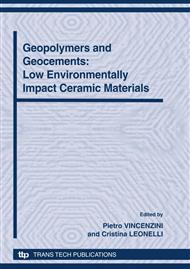p.135
p.143
p.152
p.156
p.164
p.174
p.180
p.186
p.192
Geopolymers as Waste Encapsulation Materials: Impact of Anions on the Materials Properties
Abstract:
One of the most promising applications of geopolymers is their use as waste encapsulating matrix. These binders are indeed compatible with aqueous waste streams and capable of activating several chemical and physical immobilization mechanisms for a wide range of inorganic waste species. Several works have investigated the immobilization of cations, mainly heavy metals or radioactive wastes, but very few studies are taking counterions, namely anions, into account. The aim of this work is to experimentally investigate the impact of anions with different valences on the materials’ properties in regard to the requirements of an industrial process at ambient or slightly elevated temperature: among others setting time, maximum achievable compressive strength or resistance to leaching. The modifications caused by the introduction of monovalent and divalent anions, such as sulphate and nitrate, are also monitored in term of mineralogy, porosity and microstructure. Their immobilization seems to be related to the advancement of geopolymerization reaction. On another hand, depending on the alkali ions used in the activation solution, the anionic species considered may also enhance the precipitation of some zeolites.
Info:
Periodical:
Pages:
174-179
Citation:
Online since:
October 2010
Authors:
Keywords:
Price:
Сopyright:
© 2010 Trans Tech Publications Ltd. All Rights Reserved
Share:
Citation:


